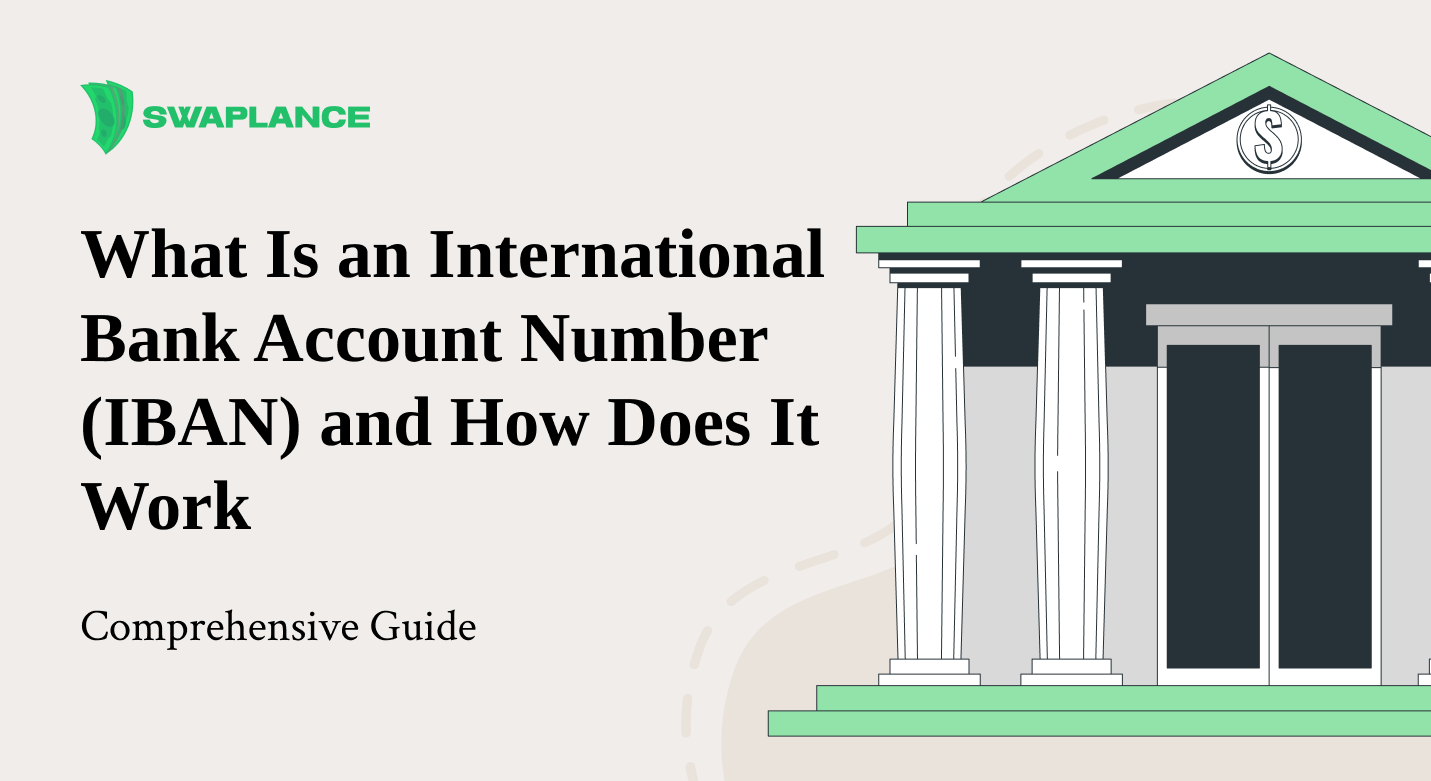
What Is an International Bank Account Number (IBAN) and How Does It Work?
The International Bank Account Number (IBAN) is a standardized system of identifying bank accounts across national borders, enabling international transactions to be processed accurately and efficiently. IBAN consists of up to 34 alphanumeric characters that uniquely identify a customer's bank account, including country code, check digits, and bank account details. When asking, "What is IBAN?", it refers to this unique identifier, crucial for cross-border transactions, ensuring that funds are transferred accurately to the intended recipient.
What is an IBAN?
To answer the question of what an IBAN number is more directly, it is a system used by banks to streamline cross-border payments by providing a globally recognized format for identifying bank accounts. This ensures that funds are transferred directly to the correct account without issues.
An IBAN consists of up to 34 alphanumeric characters, which include:
- Country Code: The first two letters represent the country where the bank account is held.
- Check Digits: The next two digits are check numbers used to validate the IBAN.
- Bank Identifier: A specific series of characters that identifies the bank.
- Account Number: The individual bank account number within the bank.
When making international payments, the sender needs the recipient's IBAN to ensure that funds are transferred directly to the correct account. The IBAN and other identifiers like SWIFT codes facilitate secure and efficient international money transfers.
Structure of an IBAN
The structure of an International Bank Account Number (IBAN) is designed to identify a bank account in international transactions uniquely. An IBAN is composed of up to 34 alphanumeric characters, which are divided into distinct parts:
- Country Code: The first two letters represent the country where the bank account is held. This is based on the ISO 3166 alpha-2 standard (e.g., "GB" for the United Kingdom).
- Check Digits: The next two digits are check digits that validate the accuracy of the IBAN. These are calculated using a specific algorithm to ensure the correct entry and processing of the IBAN.
- Basic Bank Account Number (BBAN): This section follows the check digits and contains the domestic bank account number, including a bank identifier and the account number itself. The format of the BBAN varies from country to country but generally includes the bank code and the actual account number. An IBAN number for a bank lies in its function to provide a unique, globally recognized code for that bank account.
The IBAN structure ensures that each international transaction is processed with a unique, standardized bank account identifier, minimizing errors and improving efficiency.
How Does an IBAN Work?
The IBAN system works by providing a standardized format for bank accounts that is recognized globally, enabling seamless international money transfers. When a sender uses an IBAN, the bank processes the transaction by identifying the correct bank and account number through the standardized code, ensuring that funds are directed accurately. The IBAN card number is often confused with credit card numbers, but it specifically refers to the bank account identifier used in international banking.
An IBAN number for a bank refers to the unique international identifier assigned to a customer's bank account. It includes a country code, check digits, and the Basic Bank Account Number (BBAN), which encompasses the bank's code and the actual account number. This number ensures that the bank account is correctly identified in international transactions.
An IBAN card number typically refers to the bank account number associated with an international bank card, such as a debit or credit card. However, it's important to note that the IBAN itself does not replace the card number but rather provides the account number linked to the card for international transactions. The IBAN is used primarily for bank transfers, while the card number is used for transactions related to the card itself.
Here's how IBAN functions:
- Initiation: When making an international payment, the sender provides the recipient's IBAN. This ensures that the funds are directed to the correct account in the proper country.
- Validation: The IBAN's structure includes check digits that verify its accuracy. Banks use these digits to perform a validation check before processing the transaction, reducing errors and delays.
- Routing: Once validated, the IBAN helps route the payment through international banking networks to the recipient's bank account. The bank can easily identify the recipient's country, bank, and account number through the IBAN.
Importance of Using IBANs
The use of IBANs is crucial in international banking for several reasons. Firstly, it minimizes the risk of errors in cross-border payments by providing a standardized format that is recognized globally. Secondly, it speeds up processing times, as banks can quickly and accurately route payments using the IBAN system. The benefits of IBAN include reduced processing costs, lower chances of returned payments, and increased efficiency in global banking. The importance of IBAN cannot be overstated, as it plays a key role in facilitating secure and efficient international financial transactions.
How to Find Your IBAN
Finding your IBAN is straightforward. It is usually available on your bank statement or can be accessed through your online banking platform. Most banks also provide a tool on their website where you can generate your IBAN by entering your bank account details. You can log into your online banking, check your account statements, or use your bank's IBAN calculator. The process is designed to be user-friendly to ensure that customers can easily access their IBAN for international transactions.
To find your International Bank Account Number (IBAN), follow these steps:
- Check Your Bank Statement: Most bank statements include your IBAN. Look for a series of letters and numbers, often labeled as "IBAN."
- Online Banking: Log in to your online banking account. Navigate to the account details or profile section, where you should find your IBAN listed.
- Mobile Banking App: If you use a mobile banking app, you can usually find your IBAN in the account information section. It may be under a menu labeled “Account Details” or similar.
- Bank's Website or Customer Service: Some banks provide a tool on their website to generate your IBAN if you know your account number and sort code. Alternatively, you can contact your bank’s customer service for assistance.
- Bank Branch: Visit your bank branch and request your IBAN from a bank representative. They can provide it to you along with any other necessary account information.
Your IBAN typically consists of your country code, check digits, bank identifier, and your standard bank account number, formatted according to international standards.
Common Uses of IBANs
IBANs are commonly used in various types of international transactions, including sending or receiving payments between different countries, making cross-border wire transfers, and conducting business with foreign companies. Other common uses of IBANs include paying for goods and services from international vendors, receiving overseas remittances, and transferring funds between international bank accounts.
IBANs (International Bank Account Numbers) have several key applications in international banking and finance:
- International Transfers: IBANs are primarily used to facilitate international wire transfers between banks. They ensure that funds are transferred to the correct account in the correct country, reducing errors and delays.
- Cross-Border Payments: International businesses use IBANs to send and receive payments across different countries. The use of IBANs standardizes account identification, making cross-border transactions more efficient.
- SEPA Payments: Within the Single Euro Payments Area (SEPA), IBANs are used for both domestic and cross-border euro payments. They streamline payments across participating countries by eliminating the need for separate account numbers and bank identifiers.
- E-commerce Transactions: Online businesses often use IBANs to process international customer payments. This ensures that payments are routed correctly, especially when dealing with multiple currencies and countries.
- Compliance and Regulatory Reporting: Banks and financial institutions use IBANs to comply with international banking regulations and reporting requirements. The standardized format of IBANs helps track and audit financial transactions across borders.
These applications of IBANs contribute to the smooth operation of global banking and commerce, enhancing the accuracy and efficiency of international financial transactions.
IBAN vs Other Bank Codes
While IBAN is primarily used for international transactions, other bank codes, such as SWIFT/BIC and routing numbers, serve different purposes.
IBAN vs SWIFT: the difference lies in their use. IBAN identifies the specific bank account, while SWIFT (or BIC) codes identify the bank itself.
IBAN vs routing number: The former is used for international transactions while routing numbers are used primarily within the U.S. banking system.
Each of these codes plays a crucial role in different aspects of banking, with IBAN being the go-to for international bank transfers.
Future of IBAN in Global Banking
The future of IBAN is closely tied to the growth of international banking and the increasing need for standardized financial processes in a globalized economy. As more countries adopt the IBAN system, its usage is expected to grow, further simplifying cross-border payments. The future trends in IBAN usage include potential enhancements in security features, reducing errors by making money transfers, broader adoption across more countries, and integration with digital and mobile banking platforms. The continued expansion of IBAN in global banking is expected to contribute significantly to the efficiency and security of international financial transactions. By choosing experts who understand the true importance of improving security and reducing errors, you can ensure a secure and prosperous financial environment for your business.
Common questions
-
How does an IBAN enhance international banking transactions?An IBAN (International Bank Account Number) enhances international banking transactions by providing a standardized format for identifying bank accounts across different countries. This standardization reduces errors and ensures that funds are transferred to the correct account, improving the accuracy and efficiency of cross-border payments. Additionally, using IBANs minimizes delays and complications in international transactions by facilitating seamless communication between banks, leading to faster processing times and greater transparency in the global banking system.
-
What information does an IBAN contain, and how is it structured?An IBAN (International Bank Account Number) contains critical information for identifying a specific bank account in international transactions. It typically includes a two-letter country code, two check digits, and a Basic Bank Account Number (BBAN) that may comprise a bank identifier and an account number. The IBAN is structured to ensure that all parts of this information are accurate and standardized, allowing for smooth and error-free processing of cross-border payments. This structure facilitates the identification of the correct account and bank, reducing the chances of misdirected transactions.
-
How is an IBAN different from other bank account identifiers like SWIFT codes?An IBAN (International Bank Account Number) and a SWIFT code serve different purposes in international banking. An IBAN identifies individual bank accounts across borders, ensuring payments reach the correct account. In contrast, a SWIFT code, also known as a Bank Identifier Code (BIC), identifies specific banks and financial institutions globally. While the IBAN provides account-specific details, the SWIFT code facilitates the secure and standardized transmission of financial messages between banks, such as payment instructions. Together, they ensure that international transactions are both accurately directed and securely processed.
 Mark Petrenko
Mark Petrenko 




